|
|
|
Sort Order |
|
|
|
Items / Page
|
|
|
|
|
|
|
| Srl | Item |
| 1 |
ID:
144848
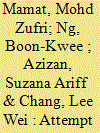

|
|
|
|
|
| Summary/Abstract |
This paper examines the influences of Malaysia's Federation Land Development Authority (FELDA) scheme in fostering inclusive rural development. Based on the model of holistic inclusive development, the paper investigates the performance of FELDA from four perspectives: social development, industrialisation, modernisation and basic needs. The main findings of the study indicate that, to a large extent, the scheme has successfully stimulated both the social and economic development of the community. Nonetheless, establishing a strong trust, social cohesion and rapport between the public authorities and community remain the main challenges in determining the success of this state-led agenda. Moreover, keeping traditional values in the modern system will be the key principle for the sustainability of the programme if plans are made to adopt the scheme in other regions.
|
|
|
|
|
|
|
|
|
|
|
|
|
|
|
|
| 2 |
ID:
144845


|
|
|
|
|
| Summary/Abstract |
State security is a key concern for countries when dealing with transboundary river governance issues. While there is a considerable amount of literature on transboundary river cooperation in general, there has been little on transboundary cooperation and the damming of shared rivers in terms of their impacts on state security. As a result, this article seeks to answer the following questions in relation to the lower Mekong basin: (i) How is the damming process embedded in transboundary cooperation? (ii) How does this type of cooperation contribute to peace and security in the study area – the 3S river basin? And, (iii) how can transboundary cooperation be improved so as to address state security issues? To answer these questions, this study reviews the relevant literature and uses two case studies, one of the Yali Dam in Vietnam and the second of the Lower Sesan 2 Dam in Cambodia. In doing so, the article examines dam developments in the lower Mekong basin, their environmental and human security impacts, and how they contribute to or threaten state security in Cambodia. It concludes that dams on international rivers induce insecurity among states downstream and that cooperation between riparian states is key to addressing this insecurity.
|
|
|
|
|
|
|
|
|
|
|
|
|
|
|
|
| 3 |
ID:
144842


|
|
|
|
|
| Summary/Abstract |
This paper draws on extensive island examples with a view to offer ‘creative’ solutions to the ongoing dispute over the Diaoyu/Diaoyutai/ Senkaku Islands between China (and Taiwan) and Japan in the East China Sea. In spite of the rhetoric and apparent intractability of island conflicts, there are various examples from the past (and the present) that suggest how island disputes may be decided, and in ‘win–win’ ways, to the satisfaction of the different parties involved. The resolution of island territorial problems can benefit greatly from a critical appreciation of how other small islands, also contested, have had their situation resolved in non-zero-sum ways. In such cases, sovereignty has been shared, split/divided or expunged; in other cases, sovereignty disputes have been put aside in order to co-develop and co-exploit natural resources. There is also one example of a UNESCO World Heritage Site consisting of a string of small islands and surrounding waters whose management is shared between three countries.
|
|
|
|
|
|
|
|
|
|
|
|
|
|
|
|
| 4 |
ID:
144846
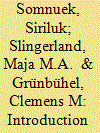

|
|
|
|
|
| Summary/Abstract |
As part of the Thai Government's objective to increase energy security through biodiesel, oil palm was introduced to Northeast Thailand in 2005. Nong Khai Province was selected as a pilot project because of its suitable environmental conditions. This study assesses the acceptance of policy interventions and socio-economic conditions by adopters and non-adopters. We found that total farmland size was significantly higher among oil palm producers than among non-producers. Nevertheless, the area under oil palm cultivation did not increase in accordance with land size in the way rubber did. Oil palm and non-oil palm farmers had almost equal amounts of rice area thereby providing household food security. Oil palm did not replace food crops. Farmers investing in oil palm tend to base their livelihood around on-farm production, whereas non-adopters tend to diversify with off-farm income sources. Oil palm was found to be one component of a diversified farming system and an additional income source, albeit not the primary one. In conclusion, oil palm was a crop that had been tried by (wealthier) farmers with sufficient capital, and an aim to further diversify on-farm household income. Oil palm is certainly not (yet) contributing substantially to household income in Thailand's Northeast.
|
|
|
|
|
|
|
|
|
|
|
|
|
|
|
|
| 5 |
ID:
144841


|
|
|
|
|
| Summary/Abstract |
It is widely assumed that the impacts of climate change on atolls will render them uninhabitable. The Carteret Islands, an iconic Pacific atoll, is experiencing physical changes, documented in the media, the outcome of multiple factors, alongside critical economic livelihood problems. Its population has sought to resettle on nearby Bougainville Island, but land has not become available. The search for migration opportunities parallels trends on coral atolls elsewhere where survival strategies have involved regional and international ties, with cultures of migration, focused on more distant international destinations. Carteret Islanders have not been able to mobilise similar relationships. For many atolls and atoll states, migration has increasingly become a livelihood strategy, irrespective of climate change. That is likely to become even more true in the future, but the outcome will be dependent on policies and practices in metropolitan destination states.
|
|
|
|
|
|
|
|
|
|
|
|
|
|
|
|
| 6 |
ID:
144844


|
|
|
|
|
| Summary/Abstract |
The promotion of intensive farming through organic and fair trade certification appears contradictory to the increasing significance of non-farm income sources in rural Asia as well as in many other parts of the rural South. By observing a sugarcane producer co-operative comprising land reform beneficiaries in the Philippines, this paper explores the reality of livelihood diversification as practised by member households of the certified co-operative, focusing on the compatibility of certification-supported farming with diversified activities. In this case, diversification at the household level progressed both away from farming and into farming. Behind the long-term use of agricultural certification, there are compelling reasons for continuing both certification-supported farming and diversified activities, and for employing mechanisms that further the compatibility at all phases between the former and the latter, and maximising income-generating opportunities. The operation of communal land with agricultural certification may be an effective form of assistance to land reform beneficiaries who share a strong desire to be landowners.
|
|
|
|
|
|
|
|
|
|
|
|
|
|
|
|
| 7 |
ID:
144849
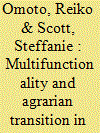

|
|
|
|
|
| Summary/Abstract |
Processes of globalisation in the conventional food provision system have had widespread negative impacts on small-scale farmers. Yet, alternative food networks, which are characterised by more sustainable production/consumption practices and fairer trade relations, have increasingly been ‘going global’ and, in the process, have been integrating small-scale farms in the South. One such high-value export-led commodity is certified organic shrimp. International third-party certification schemes are becoming popular as a tool to verify the intangible attributes of such commodities. Using concepts of multifunctionality and agrarian change, this paper examines the implications of introducing an international environmental certification programme to a site where the ‘peasantry’ has been preserved and has limited integration in the global agro-food system. Drawing on a case study that examines the first certified organic shrimp production project in Vietnam, this paper concludes that the current movement towards post-productivism in the global North has potential to keep local farming practices in the global South by justifying the value of peasant-like production methods through international certification. As a result, the development path of agrarian transition might be reshaped into a form not necessarily pursuing industrialisation. This leads to the new interpretation of pre- and post-productivism beyond the North and South divide.
|
|
|
|
|
|
|
|
|
|
|
|
|
|
|
|
| 8 |
ID:
144843
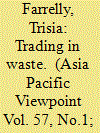

|
|
|
|
|
| Summary/Abstract |
This paper provides a broad survey of existing literature on contemporary solid waste management (SWM) in the Pacific region to underscore an urgent and compelling need for improved SWM. Despite advances in waste management systems and funding for technical support and capacity building from a range of sources, waste continues to threaten public and ecological health and the economy in Pacific Islands Countries and Territories (PICTs). SWM in the Pacific requires innovative thinking in a challenging environment of remoteness, limited available land, fragile ecosystems, vulnerability to natural hazards and subsequent climate sensitivity. Many PICTs are under considerable pressure to open their markets up to trade liberalisation. Increasing links to the global economy through trade liberalisation could either further exacerbate waste management challenges in the Pacific or contribute to environmental protection and sustainable development goals. The authors argue that if the PICTs' urgent waste management challenges are to be meaningfully addressed, the region's leaders must ensure trading partners conform to local environmental protection policies and that trade agreements align with sustainable development goals.
|
|
|
|
|
|
|
|
|
|
|
|
|
|
|
|
| 9 |
ID:
144847
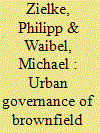

|
|
|
|
|
| Summary/Abstract |
Over the past several years, the creative reuse of brownfields has played a major role in Chinese cities to give their urban landscape a so-called second development. This paper analyses the governance of the brownfield restructuring in Guangzhou (Canton). The research is based on a study of the T.I.T Creative Industry Zone, a highly successful creative space currently in danger of demolition. This paper follows DiGaetano and Strom's (2003) analytical governance framework. This approach allows for deciphering the complexities of decision-making through a well-structured set of interdependent categories. In Guangzhou, new policies and institutions have been promoting the restructuring and have contributed to the formalisation of public–private interactions. In general, this indicates a shift towards a more corporatist governance. However, the study of T.I.T reveals a rather intricate picture: the policymaking remains influenced by a top-down authoritative style – sometimes in an arbitrary manner – and to some extent also by particularistic exchanges. This indicates a complex mode of urban governance consisting of increasingly corporatist elements but still with managerial, and to a lesser extent, clientelistic elements. Finally, the coexistence of different governance modes seems to be a typical outcome of China's transition while still remaining more adaptive, experimental and flexible in nature.
|
|
|
|
|
|
|
|
|
|
|
|
|
|
|
|
|
|
|
|
|